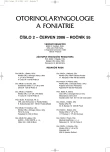Serum Levels of IL-2, IL-4, IL-10 and IGFß1 and their Comparison with Markers of Angiogenesis and Apoptosis in Carcinoma and Chronic Inflammation of Tonsil
Authors:
J. Astl 1; D. Veselý 1; T. Kučera 2; J. Martínek 2; H. Pácová 1,2; I. Šterzl 3; J. Betka 1
Authors‘ workplace:
Klinika otorinolaryngologie a chirurgie hlavy a krku l. LF UK a FN Motol, Praha
1; Ústav histologie a embryologie l. LF UK, Praha
2; Ústav mikrobiologie a imunologie l. LF UK, Praha
3
Published in:
Otorinolaryngol Foniatr, 55, 2006, No. 2, pp. 88-91.
Category:
Original Article
Overview
Introduction:
The present time the immune and defense mechanisms going on during pathological processes in relation to the origin and development of tumors are under study. In the course of inflammation, cytokines Th1-Th2 are releases and their relation to tumor transformation have especially recently become the subject of investigation. The relation of cytokines and information molecules, including the growth factors, to spinocellular carcinoma of head and neck and their relation to lymphatic tissue or Th1-Th2 to lymphomas, has not been studied yet.
Objective:
To determine the role of cytokines in the pathogenesis of oropharngeal tumors
Methods:
The concentration of cytokines IL-2, IL-4, IL-10 and TGFß1 were examined from blood serum taken from patients suffering from cancroid carcinoma of the tonsil (N=17) and patients before the operation on chronic inflammation of the tonsils (N=11). The determination of cytokines was performed by the method of ELISA (Dako Kit) with controls (doublets) in blood serum. Apoptosis was examined immunohistochemically in sampled tumor tissue of the tonsil tumor or the tonsil with chronic inflammation by means of the markers of caspase 3 an Ki67. The authors also detected the activity of eNOS (endothelial NO synthase). The individual markers were determined by the three-step procedure using antibodies labeled with Vactastain ABC Elite and the diaminobenzidine stain. SA statistical analysis was performed by Mann-Whitney test, after testing comparability of the groups.
Results:
In the patient with the tonsil cancer, the levels of IL-10 (8.97 pg/ml, STD 13.76 pg/ml) and IGFß1 (89.75 ng/ml, STD 98.35 ng/ml), in patients with chronic tonsil inflammation the values were 2.95 pg/ml, STD 23.08 pg/ml) and IGFß1 (49.61 ng/ml, STD 29.54 ng/ml).
Conclusion:
The presented data have demonstrated the expression of Ki67, apoptosis (caspase 3), angiogenesis (eNOS) and expression of cytokines IL-10 and TGFß1 in the tissues affected by chronic inflammation of the tonsil as well as the spinocellular carcinoma of the tonsil. It is therefore possible to hypothesize that chronic inflammation may potentiate or participate in tumor transformation of the cells in the tonsil tissue.
Key words:
chronic inflammation, oropharynx, tumors, cytokines, apoptosis, growth factors.
Labels
Audiology Paediatric ENT ENT (Otorhinolaryngology)Article was published in
Otorhinolaryngology and Phoniatrics

2006 Issue 2
Most read in this issue
- Tonsicellectomy in the Cold and Warmth
- Nodular Cervical Metastases of Spinocellular Carcinoma of Oropharynx and Pharynx (Part 2)
- Mucosal Melanomas of the Head and Neck
- Surgical Treatment of Cholesteatoma
